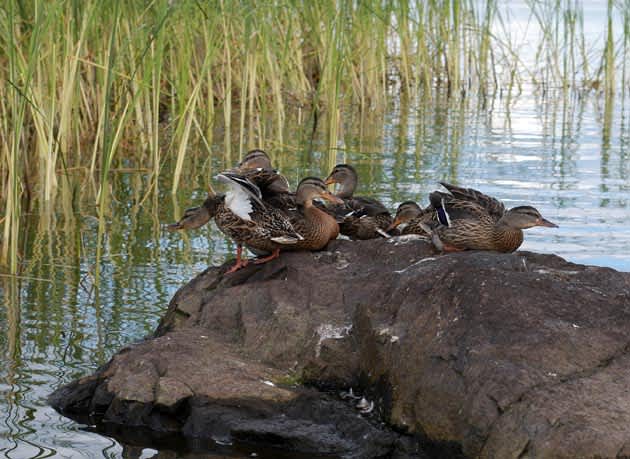Ducks Are Up, Stamp Sales Are Down: What Can We Do?
Patrick Durkin 03.26.13

Two newspaper articles slid into my email box a day apart a few weeks ago, complete with their senders’ predictions of doom and darkness for waterfowl hunting if we don’t read and take heed.
The first article told of a novice hunter who killed an endangered whooping crane in Texas, but turned himself in for the mistake. My correspondent called the guy “stupid”–a fair commentary, I suppose–and warned similar mistaken-identity cases would occur if states like Wisconsin could hunt sandhill cranes.
Hmm. Maybe, but sandhill crane hunting wasn’t legal where the Texan killed the whooper, so where’s the foolproof protection?
The second article reported a scientific study evaluating declines in federal “duck stamp” sales. These $15 stamps are mandatory for waterfowl hunters nationwide. The study notes that as waterfowlers quit hunting, conservation suffers because about 98 percent of money from duck stamps buys or leases critical habitat for national wildlife refuges, and helps manage it.
The study, led by researcher Mark Vrtiska of the Nebraska Game and Parks Commission, found declining stamp sales cost waterfowl conservation programs about $126 million from 1995 to 2008.
So, which problem poses worse threats to North American waterfowl, one mistakenly killed whooping crane or plunging duck stamp sales?
Judging by the endless “reader feedback” insults below the dead-crane article, hunters and non-hunters prefer focusing on the dead whooper. Non-hunters indict all hunting and hunters while cynically dismissing their conservation ethic. Hunters return the slurs, and taunt antagonists with crane recipes.
Sigh.
Don’t you wish both sides would abandon their keyboards, shed their slippers and sweat pants for waders and woolen clothes, walk outside and quit writing anonymous e-nasties on the Internet’s outhouse walls? If we care about all waterfowl–not just individual cranes–we must work to reverse declines in conservation funding.
It won’t be easy. In a February 5 article in the Wildlife Society Bulletin, Vrtiska writes that waterfowl hunter numbers are declining even as today’s waterfowl and hunting opportunities exceed anything documented the past century.
Since 1995, six of 10 ducks species regularly monitored by researchers reached record numbers. And since 1955, breeding-duck populations in survey areas exceeded 40 million only nine times, but six of those years were since 1995. Those big duck numbers supported longer hunting seasons and greater bag limits than anything seen since the early 1970s.

Even so, annual duck stamp sales fell 36 percent from an average of 2.2 million in the 1970s to 1.4 million during the 2004-2008 hunting seasons. Granted, similar declines in overall hunter numbers and license sales hurt all wildlife management programs. But the loss hits waterfowl conservation especially hard because it depends so much on duck stamps.
This ongoing decline marks the first time hunter numbers fell while duck numbers climbed. Historically, waterfowler numbers rose and fell in relation to duck numbers. Starting in the 1990s, that correlation vanished.
What’s the economic impact of that decline? Vrtiska’s researchers estimate 600,000 more stamps would have been sold between 1995 and 2008 than what actually occurred, which meant annual average losses of $9 million during the 14-year period.
Vrtiska’s team also predicts hunter numbers will keep declining–not only from social, cultural, and economic factors–but also because certain duck populations will soon peak. When their numbers fade with habitat losses, they’ll trigger shorter seasons and smaller bag limits. After analyzing three scenarios to predict such impacts, the researchers estimated future duck stamp losses up to $14.3 million annually.
In turn, as hunter numbers decline, private hunter-based conservation organizations will struggle to maintain habitat projects. The researchers expect corresponding funding losses from federal excise taxes paid by hunters on firearms and ammunition through the Pittman-Robertson Act.
So, what to do? Even though more than 70 million U.S. citizens say they’re wildlife watchers, few buy duck stamps. Nor do groups they support urge such purchases. Vrtiska suggests a compromise: require everyone entering a national wildlife refuge or waterfowl production area–whether to hike, fish, bird-watch, or hunt deer or other game–buy a duck stamp.
In addition, require all migratory bird hunters–including those hunting coots, rails, snipes, woodcocks, moorhens, and mourning doves–buy a duck stamp. And rename it the “Federal Migratory Bird Habitat Conservation Stamp,” to reflect its full mission.
In that spirit, maybe we should consider sandhill cranes, whooping cranes, and trumpeter swans for the old “duck stamp.” They would make excellent poster boys for waterfowl conservation.

